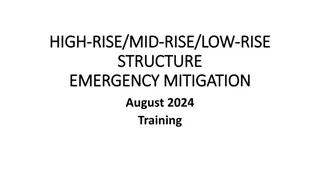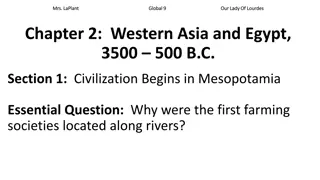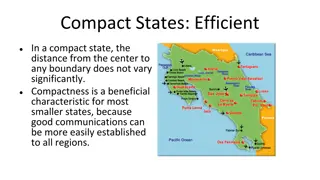Understanding the Rise of Sumerian City-States in Mesopotamia
Small farming villages in Mesopotamia developed into independent city-states around 3500 B.C.E. These early settlements faced challenges such as food shortages, uncontrolled water supply, difficulties in irrigation, and attacks from neighboring communities. The inhabitants built walled cities with farmland for sustenance and protection, adapting to the harsh environment of Mesopotamia.
Uploaded on Sep 09, 2024 | 3 Views
Download Presentation

Please find below an Image/Link to download the presentation.
The content on the website is provided AS IS for your information and personal use only. It may not be sold, licensed, or shared on other websites without obtaining consent from the author. Download presentation by click this link. If you encounter any issues during the download, it is possible that the publisher has removed the file from their server.
E N D
Presentation Transcript
The Rise of Sumerian States Mr. Korinek 7thGrade Social Studies
MesopotamiaThe Land Between Two Rivers Small farming villages developed in the rolling hills and low plains of Mesopotamia These villages were located in the southern part of this land, an area called Sumer These early cities date back to about 3500 B.C.E were like small, independent countries They each had their own ruler and their own farmland to provide food (city-states)
Imagine Imagine you are visiting one of these early cities. You see a walled settlement surrounded by farmland that supplies food for the city. The strong city walls are built of sun baked bricks. Moats, or ditches filled with water surround the walls. The moats help to keep out enemies. During an attack, people living outside the city walls flea inside for protection.
Mesopotamia: A Difficult Environment Mesopotamians faced four key problems as they tried to survive in a harsh environment Food shortages in the hills An uncontrolled water supply on the plains Difficulties in building and maintaining irrigation systems to serve the needs of several villages at once Attacks by neighboring communities
Food Shortages in the hills Around 5000 B.C.E farmers did not have enough land to grow food for the increasing number of people. As a result, villages began to suffer food shortages. The plains for most of the year were hard and dry The plains lacked trees and stones for making shelters and tools However in the spring the rivers flooded, bringing precious water. Driven by the need for food, people moved out of the foothills onto the plains
Uncontrolled water supply Farmers who moved to Sumer faced many challenges, like the uncontrolled water supply During the spring, rain melted snow from the mountains flowed into the Tigris and Euphrates Rivers, causing them to flood across the plains. Faced with dramatic seasonal changes, farmers struggled to raise crops. They needed a way to control the water to have a water supply all year long. So they created irrigations systems to water their fields.
Irrigation Sumerians built levees along the sides of the river to prevent flooding. When the land was dry, they poked holes in the levees, and the water flowed through the holes onto the thirsty fields. Over time the Sumerians learned other ways to control the supply of water. They dug canals to shape the paths the water took. They also constructed dams along the river to black the water and force it collect in pools for later use.
Difficulties in building and maintaining the irrigation system The irrigation systems provided enough water for Sumerian farmers to grow plenty of food. But now a new problem arose; how to maintain the irrigation system across village boundaries. The system had to be maintained constantly. The canals had to be regularly cleaned as they became clogged with silt. (very fine mud) Even one clogged canal could ruin the entire system. Farmers had to work together for the common good. Gradually these villages came to depend on one another. As the Sumerians worked together, they began to create larger communities. Between 3500 and 3000 B.C.E, villages grew into towns, and some towns became cities with populations as great as several thousand people.
Attacks by Neighboring Communities As Sumerian cities grew, they fought over the right to use more water. Sometimes cities located upriver (closer to where the river begins) built new canals or blocked other cities canals. This kept water from reaching cities down river (farther from where the river begins). Fights over water became so intense that they led to bloodshed and killing.
Protection Because their were no natural barriers for protection, Sumerians began to build strong walls around their cities. The walls were made of mud bricks that baked in the sun until they were hard. The Sumerians also began to dig moats outside city walls to prevent enemies from entering the city. Most people lived in houses behind the walls, while the farms lay outside . In case of attack, farmers fled the fields and took safety inside the city walls.
From Small Farming Villages to Large City-States The Sumerians went from living in small farming villages to building large walled cities, How and why did this happen? The answer lies in the problems and how the Sumerians solved them. The basic challenge for any group is how to proved food for itself. Food shortages forced settlers to move from the foothills down to the river valley. The farmers faced the problem of having either too much or too little water. To control the water supply, Sumerians built a complex irrigation system, that crossed village boundaries, so the Sumerians had to cooperate, causing them to live in bigger cities. Each of these cities was like an independent country. Often these city states fought with one another. To defend themselves, Sumerians built Walls and dug moats around their cities. By 3000 B.C.E, most Sumerians lived in walled city-states.






















